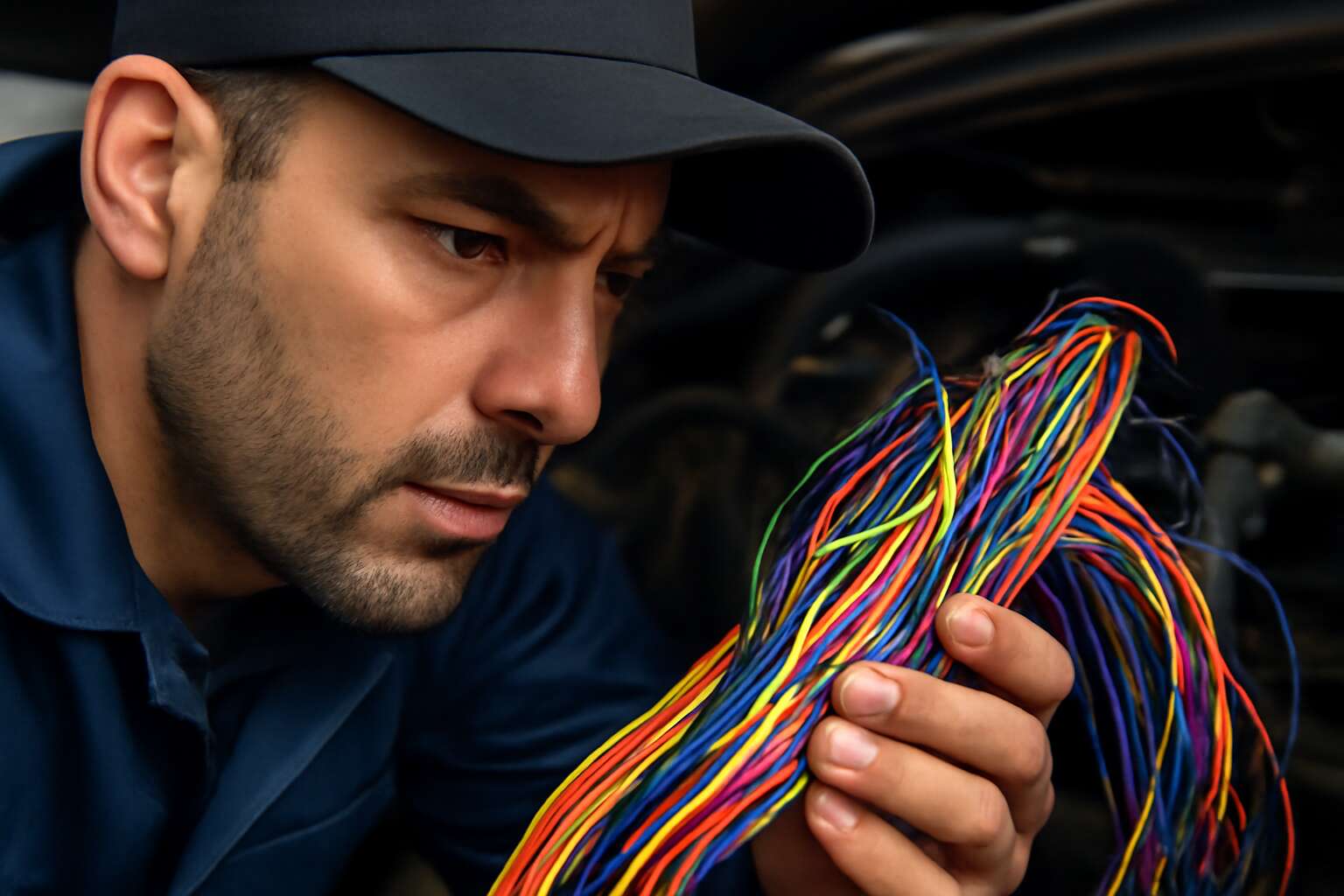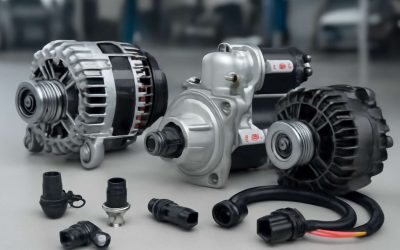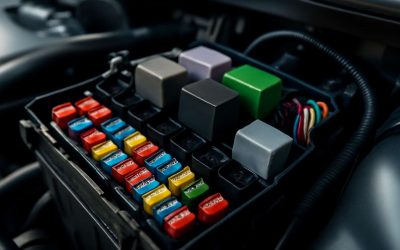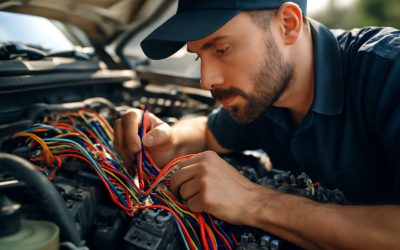Understanding Auto Electrical Systems
1 – Basics of Automotive Electrical Systems
Imagine your vehicle’s electrical system as the silent conductor of an intricate symphony. It’s easy to overlook, yet without it, your car’s heartbeat falters. The auto electrical strand forms the backbone of this complex orchestra, connecting components from the ignition to the headlights with a web of wires and circuits. Understanding the basics of automotive electrical systems reveals a fascinating world where power and precision intertwine.
At its core, the auto electrical strand encompasses a network of wires, fuses, relays, and sensors that work tirelessly to keep your vehicle running smoothly. It’s a delicate balance—each element playing a pivotal role. For instance, the alternator, a critical component, replenishes the battery, ensuring steady electrical flow. The entire system operates on a simple principle: converting chemical energy into electrical energy, then distributing it efficiently. Recognising these fundamental processes can deepen appreciation for the unseen marvel that powers modern motoring.
- Power generation via the alternator
- Distribution through wiring harnesses
- Protection provided by fuses and relays
- Control by sensors and control modules
2 – Components of an Auto Electrical Network
Within the intricate web of an auto electrical strand lies a symphony of essential components, each playing a vital role in orchestrating vehicle functionality. Unlike the more visible parts of your car, these elements are often unseen but crucial for safety and performance. The core components of an auto electrical network include a series of interconnected parts that ensure seamless power flow, control, and protection.
At the heart of this system are the sensors and control modules, which act as the brain, processing data and making split-second decisions. Surrounding them, the wiring harnesses serve as the arteries, distributing electrical signals across the vehicle. Additionally, fuses and relays are the guardians, shielding the network from overloads and faults. This complex architecture is what keeps modern vehicles operating reliably, demonstrating the true depth of the auto electrical strand’s importance in automotive engineering.
3 – Importance of Reliable Wiring and Strand
In the realm of modern vehicles, the auto electrical strand forms the invisible backbone that keeps everything running smoothly. It’s a marvel of engineering where reliability is paramount—think of it as the lifeblood coursing through your car’s veins. Without a robust and dependable wiring system, even the most advanced sensors and control modules become powerless, risking breakdowns and safety hazards.
The importance of reliable wiring cannot be overstated. A well-designed auto electrical strand ensures seamless power flow, preventing faults before they manifest. Sometimes, a tiny flaw in the wiring can cause a ripple effect, disrupting critical systems like braking or steering. To avoid this, manufacturers and technicians focus on premium-quality components, knowing that a strong electrical foundation is essential for vehicle longevity and performance.
What is Auto Electrical Strand?
1 – Definition and Function of Electrical Strand
In the intricate dance of automotive engineering, the auto electrical strand often plays a silent yet indispensable role. Think of it as the lifeblood of your vehicle’s electrical heartbeat, transmitting vital signals and power with unwavering reliability. This slender conductor isn’t just a piece of wire; it’s a carefully engineered element designed to withstand the rigours of everyday motoring, from bustling city streets to long-distance journeys.
Essentially, an auto electrical strand functions as a conduit, linking diverse components of the auto electrical system. Its primary purpose is to facilitate seamless communication and power flow, ensuring that everything from headlights to engine sensors operates harmoniously. When crafted with precision, this strand offers durability, flexibility, and resistance to environmental factors—features that are non-negotiable in the world of automotive electrical systems.
In truth, the auto electrical strand is the unsung hero that keeps your vehicle’s complex electrical network ticking like a well-oiled machine, reminding us all that sometimes, the smallest details make the biggest difference.
2 – Types of Electrical Strand Used in Vehicles
When it comes to the silent heroes of your vehicle’s electrical system, the auto electrical strand often doesn’t get the spotlight it deserves. Think of it as the trusty courier of electrical signals, ensuring everything from your dashboard lights to the engine’s sensors stay in perfect harmony. This slender yet resilient component is expertly engineered to withstand the daily rigours of motoring, from sudden rain showers to scorching summer heat.
Different types of electrical strand are utilised in vehicles, each tailored for specific roles and environments. The most common include copper and aluminium strands, renowned for their conductivity and flexibility. Copper strands are celebrated for their superior electrical performance, making them the go-to choice for critical circuits. Meanwhile, aluminium strands are prized for their lightweight nature—perfect for reducing overall vehicle weight without sacrificing durability.
Within the auto electrical strand family, you might encounter:
- Stranded copper wire, valued for its excellent conductivity and ease of flexibility.
- Aluminium strands, offering a lightweight alternative with respectable conductivity.
- Specialised coated strands, designed to resist corrosion and environmental damage—because your vehicle’s wiring shouldn’t be a corrosion party!
Choosing the right type of auto electrical strand can make all the difference in the longevity and safety of your vehicle’s electrical network. After all, you don’t want your wiring to resemble a tangled spaghetti mess when you’re just trying to get from A to B!
3 – Material Composition and Quality Standards
At the heart of every reliable vehicle’s electrical system lies a fundamental yet often overlooked component: the auto electrical strand. This slender wire acts as the vital conduit for electrical signals, seamlessly transmitting power and data across the vehicle’s intricate network. Without it, even the most advanced automotive electronics would fall silent. Its resilience and precise material composition are what keep your dashboard lights glowing, sensors responding, and engine management smooth.
The quality and durability of an auto electrical strand hinge on its material composition. Typically, high-grade strands are crafted from copper or aluminium, each offering distinct advantages. Copper, renowned for its exceptional electrical conductivity, ensures critical circuits operate with minimal resistance. Conversely, aluminium, being lightweight yet durable, helps reduce overall vehicle weight without compromising performance. To meet rigorous automotive standards, manufacturers adhere to specific quality benchmarks, such as:
- ISO 9001 certification for quality management systems.
- SAE J1127 standards for wire and cable performance.
- Environmental compliance standards to resist corrosion and environmental damage.
Choosing the right auto electrical strand isn’t merely about conductivity—it’s about resilience against the demanding conditions of daily motoring. High-quality strands are designed to withstand temperature extremes, moisture, and mechanical wear, ensuring your vehicle’s electrical network remains unbreakable through countless journeys. This is the silent hero that keeps your driving experience safe, smooth, and trouble-free.
Common Issues and Troubleshooting
1 – Signs of Faulty Auto Electrical Strand
In the shadowed corridors of your vehicle’s soul, the auto electrical strand often whispers secrets of impending doom. When these silent filaments falter, the entire symphony of your car’s electrical heartbeat can descend into chaos. Recognising the signs of a faulty auto electrical strand is crucial—before your journey becomes a ghostly spectre of frustration.
One of the most disconcerting signals is erratic lighting or sudden flickering, as if the vehicle itself is flickering between life and death. Additionally, unexplained electrical failures—such as malfunctioning alarms or dead batteries—may hint at compromised auto electrical strand. A telltale sign often overlooked is an unusual burning smell, reminiscent of decay, emanating from the wiring harness. These symptoms should never be ignored, for they foretell a potential catastrophe lurking beneath the surface.
When troubleshooting, it is vital to examine the integrity of the wiring connections, inspecting for corrosion, fraying, or discolouration. An overworked or worn auto electrical strand can lead to voltage drops, causing the vehicle to stumble in its electric dance. Employing a multimeter to measure resistance across the strands can unveil hidden faults, revealing whether the strands are still resilient or succumbing to the relentless march of time.
2 – Diagnosing Electrical Strand Failures
Electrical strand failures in your vehicle can turn a smooth ride into a chaotic dance of malfunction. These sneaky faults often manifest as intermittent power hiccups or inexplicable electrical glitches—like your dashboard lighting up in Morse code. Troubleshooting these issues requires a keen eye and a multimeter, but understanding the common culprits is half the battle won.
One frequent offender is corrosion at connection points, which acts like a silent saboteur, disrupting the flow of electricity. Frayed or worn auto electrical strand can cause voltage drops that make your vehicle stumble unexpectedly. To get to the root of the problem, start with a visual inspection—look for discolouration, cracks, or signs of overheating. Following that, using a multimeter to measure resistance across the suspected strand can reveal hidden faults.
- Check the wiring harness for physical damage or discolouration.
- Test the auto electrical strand for continuity to ensure it’s still conducting.
- Inspect connection terminals for corrosion or looseness.
If your auto electrical strand is compromised, these diagnostics are the way to unmask the culprit behind those frustrating electrical failures. After all, every vehicle’s electrical system deserves a bit of detective work before it throws a full-blown tantrum.
3 – Impact on Vehicle Performance
When an auto electrical strand falters, the ripple effect on your vehicle’s performance can be startling. Misfires, sluggish acceleration, and unpredictable stalling often stem from compromised wiring. These issues aren’t just inconvenient—they can be dangerous, especially when they strike unexpectedly on busy roads.
One of the more insidious problems is a weakened auto electrical strand, which causes inconsistent electrical flow. This inconsistency can trigger engine misfires or loss of power, directly affecting how your vehicle responds. Vehicles depend heavily on a robust electrical network; when the auto electrical strand is faulty, vital systems like ignition and fuel injection become unreliable.
Persistent electrical faults may also lead to increased fuel consumption and shortened component lifespan. In the worst cases, faulty wiring can cause complete system shutdowns, leaving you stranded. Recognising the subtle signs early on—such as flickering dashboard lights or erratic sensor readings—can help prevent these issues from escalating. After all, a healthy auto electrical strand is the backbone of smooth, dependable vehicle performance.
Choosing the Right Auto Electrical Strand
1 – Factors to Consider in Selection
Choosing the right auto electrical strand is a critical decision that can influence the longevity and safety of your vehicle’s electrical system. When selecting an auto electrical strand, it’s essential to consider factors such as material quality, flexibility, and resistance to environmental stressors. A high-quality strand not only ensures reliable current flow but also withstands the rigours of daily driving and unpredictable weather conditions.
Understanding the specific demands of your vehicle’s electrical network can help narrow down your options. For instance, some auto electrical strands are designed with superior insulation properties, making them ideal for exposed or high-moisture environments.
Furthermore, assessing compatibility with existing wiring and the overall electrical design of your vehicle can prevent future issues. Remember, the right auto electrical strand isn’t just about conductivity; it’s about durability, safety, and performance—elements that turn a simple wire into a steadfast guardian of your vehicle’s electrical soul.
2 – Compatibility with Vehicle Make and Model
Every vehicle is a unique universe, woven with intricate electrical pathways that pulse with life. When selecting an auto electrical strand, understanding compatibility with your specific make and model is paramount; it’s the key to unlocking seamless performance and lasting durability. Different vehicles demand specialised wiring solutions, and recognising these nuances can mean the difference between a reliable electrical system and persistent malfunctions.
To ensure optimal compatibility, consider consulting detailed specifications or manufacturer guidelines. In some cases, the auto electrical strand must match the vehicle’s wiring gauge, insulation standards, and environmental resilience. For instance, high-performance or off-road vehicles often require strands designed to withstand extreme heat, moisture, and vibrations. An ill-fitting or incompatible strand can lead to overheating or electrical failures, jeopardising both safety and longevity.
In essence, choosing the right auto electrical strand is akin to selecting a master key—one that must fit perfectly within the complex labyrinth of your vehicle’s electrical architecture. Paying close attention to the compatibility factors ensures not only peak performance but also peace of mind on every journey. After all, a well-matched wire is the silent guardian that keeps your vehicle’s heart beating reliably amidst the chaos of the road.
3 – Brands and Quality Certifications
When it comes to safeguarding your vehicle’s electrical longevity, choosing a reputable brand backed by recognised quality certifications is paramount. A well-made auto electrical strand isn’t just about performance—it’s about peace of mind, knowing your wiring can withstand the rigours of daily life on unpredictable rural roads or high-speed journeys alike. Quality certifications such as ISO or UL signify that the strand meets stringent safety and durability standards, ensuring resilience against heat, moisture, and vibrations.
Opting for trusted brands often means investing in materials that have undergone rigorous testing, reducing the risk of electrical failures that could leave you stranded. Look for manufacturers who provide detailed specifications and certification labels—these are your assurance of a reliable, long-lasting auto electrical strand. After all, the right brand combined with quality standards is the cornerstone of a dependable electrical system that keeps your vehicle running smoothly during every adventure.
Installation and Maintenance Tips
1 – Professional Installation Best Practices
When it comes to installing auto electrical strand, precision and adherence to best practices can mean the difference between reliable performance and costly repairs. Employing professional installation techniques ensures that the electrical system remains robust under the demanding conditions of daily driving. Expert installers typically start with meticulous route planning, avoiding sharp bends and potential sources of abrasion that could compromise the integrity of the auto electrical strand.
Using specialised tools and high-quality connectors, technicians secure each connection to prevent corrosion and voltage loss. To further enhance longevity, a comprehensive maintenance schedule should include regular inspections for signs of wear or damage, especially in areas prone to moisture or heat exposure.
- Ensure all connections are tight and corrosion-free.
- Use protective sleeves or conduits to shield the auto electrical strand from environmental hazards.
Maintaining these standards not only extends the lifespan of the electrical system but also guarantees optimal vehicle functionality over time. Proper installation and ongoing maintenance are the cornerstones of a dependable auto electrical network—trusting professionals in this process makes all the difference.
2 – Routine Inspection and Maintenance
In the realm of automotive mastery, the auto electrical strand stands as the silent conductor orchestrating the symphony of modern vehicle functionality. Yet, even the most resilient strand demands vigilant care to uphold its vital role. Routine inspection and maintenance are not merely chores but essential rituals that safeguard the integrity of this intricate web of electrical life.
Regular visual inspections reveal the subtle whispers of wear—discolouration, corrosion, or frayed insulation—warning signs that demand immediate attention. A systematic approach ensures no detail is overlooked, preserving the robustness of the electrical system. To streamline this process, consider adopting a simple yet effective checklist:
- Check all connections for tightness and signs of corrosion.
- Inspect for abrasion or damage caused by environmental exposure.
- Ensure protective sleeves or conduits are intact and shielding the auto electrical strand from moisture and heat.
Engaging in periodic maintenance not only prolongs the lifespan of the auto electrical strand but also fortifies the vehicle’s inner heartbeat. It’s an act of devotion—an unwavering commitment to the seamless journey of every mile traveled. In this dance of technology and care, the auto electrical strand remains resilient, ready to power the passion of every driver who demands reliability and performance.
3 – Safety Precautions When Handling Electrical Strand
Handling automotive electrical systems demands respect and caution—an auto electrical strand may be resilient, but it is not invincible. Safety precautions are paramount when installing or maintaining this vital component of your vehicle’s electrical network. The risk of electric shock or short circuits makes proper handling essential to prevent injury and damage.
Before beginning work, always disconnect the vehicle’s battery to eliminate the risk of accidental energisation. Use insulated tools and wear protective gloves to shield yourself from potential sparks or corrosion exposure. It’s also wise to work in a well-ventilated area, especially if you’re dealing with ageing or damaged auto electrical strand, which can sometimes emit fumes or vapours.
To further minimise hazards, follow these safety best practices:
- Ensure all power sources are isolated before handling the auto electrical strand.
- Regularly inspect your tools for insulation integrity to avoid accidental conduction.
- Keep a fire extinguisher nearby, specifically rated for electrical fires, in case of emergencies.
Remember, the integrity of the auto electrical strand directly influences vehicle safety and performance. Taking these precautions not only protects you but also preserves this delicate web of electrical life, ensuring your vehicle remains reliable mile after mile.




0 Comments